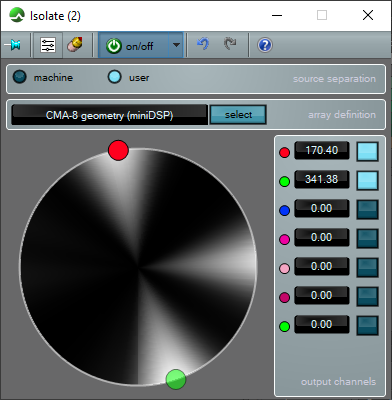Isolate™

Up to the limit determined by the number of microphones in your array, Isolate will attempt to identify all of the independent sound sources within the soundfield (not just the loudest ones). It will work with any suitable multi-channel signal, whether the geometry of the array is known or not. A Mixer is provided to allow you to mix the (up to) eight audio streams so that you can monitor a complete conversation on a typical sound system with, say, just one or two audio channels.
Machine mode
If the geometry of the microphone array is not known, Isolate will identify the most likely candidates for relevant signals in the soundfield. Up to eight candidates will be output, depending upon the number of microphones and the configuration of the CEDAR Cambridge system at that moment.
User mode
When a suitable multi-channel signal is provided by an array with a known geometry, Isolate can determine and display the directions of arrival of the sources within the incoming audio stream. You can then choose multiple directions of arrival so that each source can appear on a single, defined audio channel.
Importing existing audio
If the audio was recorded on a CEDAR Trinity system and exported to CEDAR Cambridge, the array definition is included as metadata. (See Array Manager.) If the audio was imported from elsewhere but recorded using a known array, selecting the correct array definition will again allow you to identify the sources within the soundfield. If the array is not known or no definition file exists, Isolate will itself identify the most likely source candidates.
Isolate is not a beamformer!
Blind Source Separation and beamforming are different technologies that have been designed to perform similar tasks. The major difference between them is that, whereas beamforming is a technology for steering a virtual microphone in a known direction, Isolate decomposes an unknown soundfield into multiple distinct sources of interest without a-priori knowledge of the locations of the speakers or other sounds. Each has its uses, but Isolate requires only a small array with a small number of microphones, and it significantly outperforms what is possible with beamformers over small and medium distances.